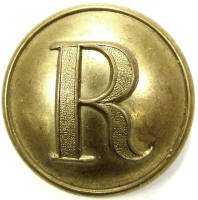
A virtual examination of artifacts of the American Civil War
 | Ridgeway Civil War Research Center,
A virtual examination of artifacts of the American Civil War |
| Civil War Artillery | |
| by Harry Ridgeway |
| Rifled artillery projectile, Parrott design, Federal manufacture, bursting shell, short pattern with flat bottom, high band brass sabot with 10 rabbets, Parrott improved one part percussion fuze, Parrott 100 pounder rifle, 6.4in. Projectile was manufactured in the Federal arsenals following development of Parrott's patent. The sabot, referred to as "type II", utilized a thin wide brass band which was softer and more flexible than wrought iron, secured to the base with 10 rabbets. However performance was poor, the thin soft brass sabot either failed to take the rifling or had a tendency to separate on firing, resulting in shards of brass flying into the backs of the forward infantry. However for large caliber guns, fired from ships or forts, flying sabots was less of a problem and this pattern of sabot became the primary convention for siege guns. Fuze employed was Parrott zinc one part percussion fuze, "improved" design, edge of the fuze hole is milled flat, Jones pg. 81. Projectile measures: diameter 6.25in., length 15.5in. (excluding fuze), weight 80lbs. approx. with sabot. Research Center: Artillery4722-Parrott, Ref: Bell Heavy Ordnance, pg. 297. Details click: http://relicman.com/artillery/Artillery4722-Parrott.html. |
| Ridgeway Civil War Research Center, A virtual examination of artifacts of the American Civil War. Artillery Research center, artillery, click: http://relicman.com/artillery/Artillery0000-Index.html. Research center, artillery, click: http://relicman.com/artillery/Artillery0000-Index.html. |
| Civil War Relicman, Harry Ridgeway, Civil War artillery, Relicman sales catalog. Click here: http://relicman.com/artillery/RelicmanSalesArtillery1.html. Artillery for sale: http://relicman.com/artillery/RelicmanSalesArtillery1.html. |